Many city dwellers who have sufficient funds build their own country house at the first opportunity. Someone comes to it only for the weekend to take a break from the hustle and bustle of the city. And someone eventually moves there to live, appreciating the beauty of peace and quiet. But in order for life in a country house to bring only joy and pleasure, you should think over every little thing long before the start of construction. And one of the hardest choices is the roof selection. Today they are very popular. They look quite elegant and unusual, which attracts thousands of potential homeowners.
However, before you start building a house, you should learn about both the pros and cons of this decision, so that they do not become unpleasant surprises in the future.
Pros and cons of a shed roof
To begin with, it's worth talking about the advantages of a pitched roof:
- Ease of installation, which positively affects the cost of construction.
- The minimum amount of materials used.
- The ability to use all types of roofing.
- Low wind resistance, which allows the use of a pitched roof in all regions, including those where strong winds often rage.
Unfortunately, a pitched roof has not only a set of positive characteristics, but also some negative ones. Knowing about them is no less (and maybe more!) Important than about their merits.
- Not very attractive appearance (compared to gable, hip and multi-gable roofs).
- The complexity of the organization of drainage. The point is that when using shed roof all the water (rain or melt) flows down to one side of the house, not two or four, which can cause a real flood if a powerful water drainage system is not provided.
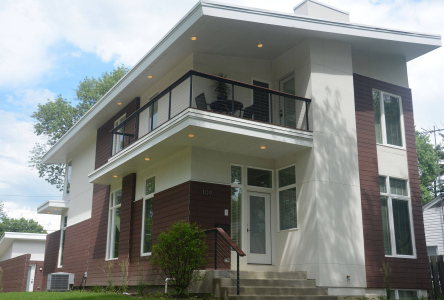
That is why in our country, when building residential buildings, pitched roofs are rarely used. But thanks to their simplicity, they can be the best solution for the construction of various buildings, be it outbuildings, garages, baths and other buildings.
If you do all the work correctly and choose the right materials, you can achieve an excellent result.
Some people prefer to create more sophisticated, more beautiful roofs on their homes. To do this, you can combine several single slopes, in which the slopes are directed in different directions or are located at different heights. At the same time, the simplicity of construction is preserved, and hence the low cost, which is highly appreciated by many customers.
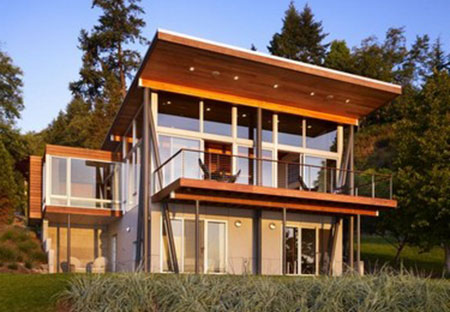 House with a pitched roof, which is built on the lake
House with a pitched roof, which is built on the lake If you decide to choose a house with a pitched roof, then you need to be very serious about choosing a specific type of roof - a lot depends on it. Therefore, it will be very useful to learn more about the different types of pitched roofs.
What are pitched roofs
Modern pitched roofs are very different. They differ in angle of inclination, construction, roofing materials and span width. All these differences need to be discussed in more detail.
According to the type of location of the supporting structure of the roof, structures are usually divided into two types:
- The roof rests on load-bearing walls that end at different heights.
- It has a one-sided triangular truss and rests on load-bearing walls of the same height.
The first option is much more popular. It is much easier to implement. Less wood is consumed. However, it is worth considering that it is necessary that one of the outer walls is high enough to provide the roof with the desired angle of inclination.
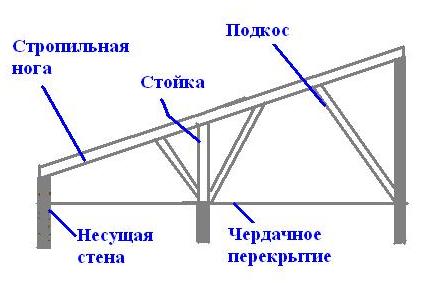
The second option is completely opposite to the first. During construction, more materials have to be used, and the installation itself has certain difficulties. But the roof is erected without raising the load-bearing wall.
Of course, you can only choose which of the options you prefer, based on your ideas about the ideal shed roof.
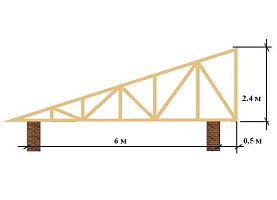
The roof can have a different number of intermediate supports to support the rafters. Several intermediate supports can be used, one, or the supports may not be used at all. The appropriate option should be determined, taking into account both the length of the rafters and the slope of the pitched roof.
During construction, the rafters must be laid on wooden floor beams. In some cases, they are laid on a Mauerlat (horizontal boards for which the wall is a support).
Read also
How to make a blind area around the house
What is the optimal tilt angle for a pitched roof
One of the most important questions associated with a pitched roof is to determine - what is the optimal slope? It depends on several factors that must be considered.
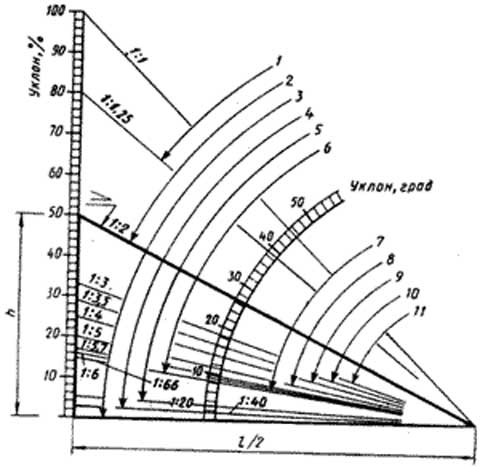
The tilt angle can be quite different - from 5 to 60 degrees. But these are extremes, and in most cases the angle ranges from 10 to 30 degrees. To choose the optimal angle, you need to consider:
- the amount of precipitation usually falling in a given region;
- the strength of the wind typical for the construction region;
- used roofing material.
If your house is located in one of the central regions of Russia, then it is best to give preference to a slope of 20-30 degrees. But for the northern and northeastern regions, where snow can fall for several weeks in a row, this figure should be at least 40-45 degrees.
Otherwise, a large amount of snow will accumulate on the roof, which over time can lead to damage. load-bearing structures or the roof itself.
Experts have long calculated the optimal slope for different roofing materials... And it will be useful to know about it.
- Roofing material - tilt angle 5-7 degrees.
- Metal tiles - 25-35 degrees.
- Slate - 20-30 degrees.
- Seamed roof - 18-28 degrees.
- Decking - 8-10 degrees.
However, there may be certain exceptions. For example, if your roof is made of lightweight materials - corrugated board or galvanized metal, it is better to slightly increase the optimal angle of inclination - not much, just a few degrees. Otherwise, in a particularly snowy and long winter, when additional pressure will be exerted on the roof for a long time, the roof may be deformed, which will lead to damage to the roof and leaks.
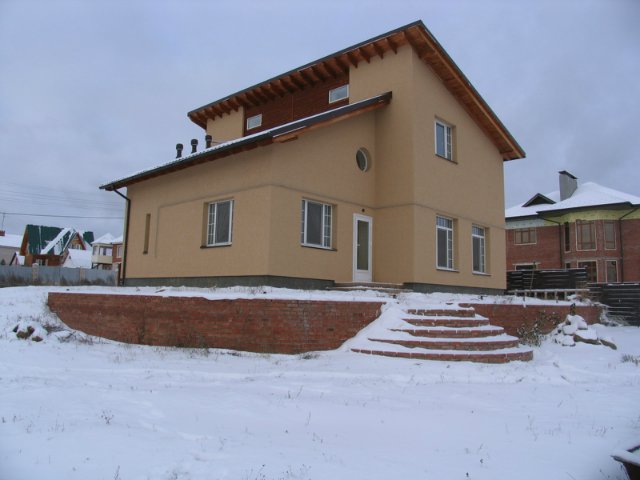
But for metal tiles or slate, the angle of inclination cannot be increased. Otherwise, the seams will not be tight enough and water may get into them.
Roof structure
To finally understand what a pitched roof is, you need to learn about its design, as well as about the varieties.
A pitched roof can be of two types: ventilated and non-ventilated. The choice of the appropriate option should be based on what the roof in the house is specifically intended for.
The non-ventilated roof is mainly installed over the terrace. In this case, its slope is relatively small - about 4-6 degrees. But such a roof will often have to be additionally cleared of snow in winter, since it will not go off by itself. 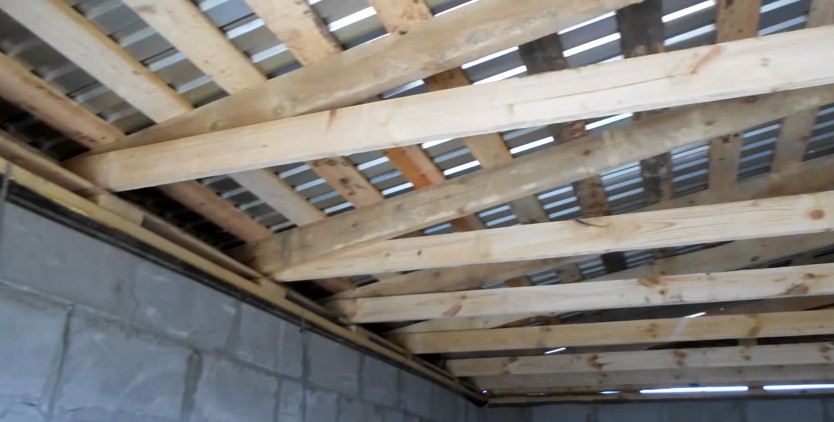
It is better to make the main roof of a residential building or bathhouse ventilated, so that the room has a good climate. Many professionals value a ventilated roof for the presence of special openings along the perimeter of the roof - thanks to them, the roof can last much longer. However, in this case, if the angle of inclination of the roof is insignificant, it will be necessary to remove the roof from snow from time to time.
If you want to build a pitched roof with your own hands, then there should not be any particular difficulties - this roof is simple. It is enough to know the theoretical part and have some hand skills.
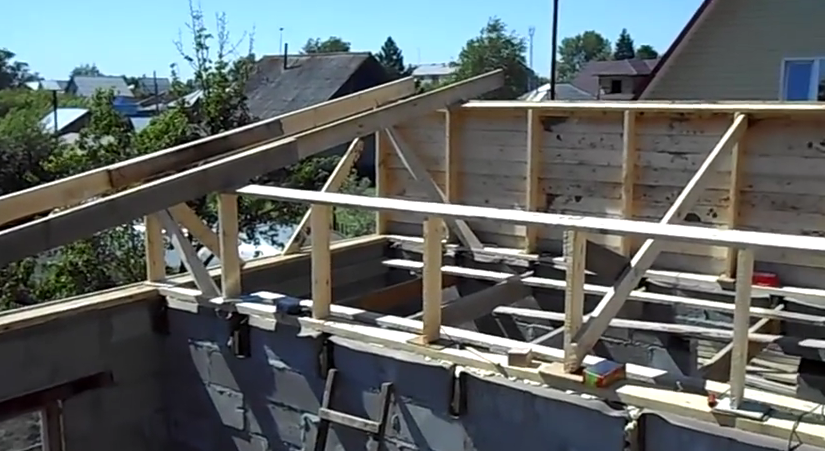
The rafter legs should rest against the Mauerlat, it will need to be done on the external load-bearing walls of the house. Therefore, the angle of inclination of the roof will depend on what is the difference in the height of the walls. If they have the same height, then you will have to provide one of them with a pediment that provides the desired height difference.
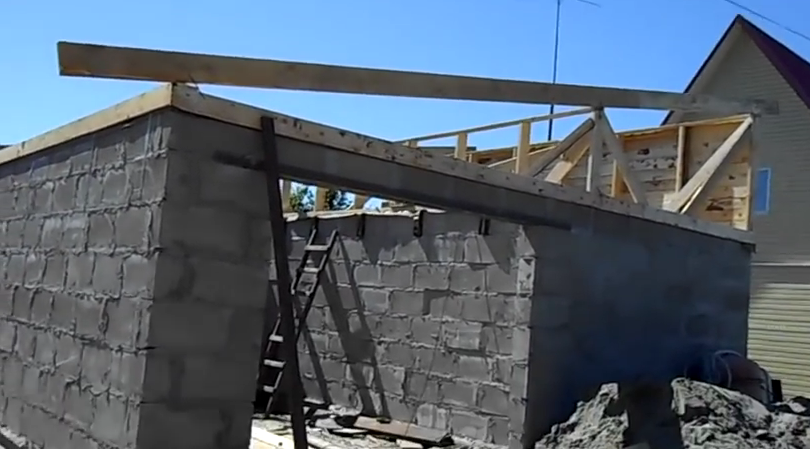
The roof structure will also depend on the span length. In some cases, if the distance between the walls is no more than 4-5 meters, it is not necessary to strengthen the rafters. When the span is 5-6 meters long, you will need to prop the rafters with a special rafter leg. In cases where the span length is 6-12 meters, a special girder will need to be installed, which will be installed on the racks. Moreover, on both sides of the rack, you need to install rafter legs, they will rest directly on the rafter.
The simplest roof structure for construction is considered to be a pitched roof, the assembly of which will not cause any particular difficulties even for beginners. An independently compiled project and construction will save on the services of professional teams (read: ""). In this case, we are talking about small country houses and premises for household purposes.
Shed roof characteristics
The erection of a shed structure will not only reduce the planned budget, but also:
- protects the roof from wind loads due to the minimal wind effect;
- if the frame of a pitched roof is recommended to be built according to a certain scheme, then the use of roofing materials is limited only by the slope of the slope;
- simple construction is being built in a short time;
- no powerful lifting equipment is required during installation, since the installation of lightweight elements can be done manually.
As with any other roof structure, a pitched roof will show several drawbacks:
- if the slope of the slope is small, then in winter high snow loads will affect the roof, which requires a careful calculation of the rafter system and the choice of their section with a margin (in more detail: "");
- because the dimensions attic space will be reduced, then even if there is a separate overlap, it cannot be used as a usable area;
- if we compare such a structure of the roof frame with other options, then to create a more attractive appearance, you will have to select modern materials.
We install the shed roof truss system
The creation of the supporting base and the roof rafter system will not cause difficulties, it is quite simple. The rafters, like the rest of the necessary elements, are made of high-quality and dried wood that has previously undergone antiseptic treatment. To choose the right cross-section of the blanks, you should calculate the value bearing capacity... On this stage it is better to invite specialists.
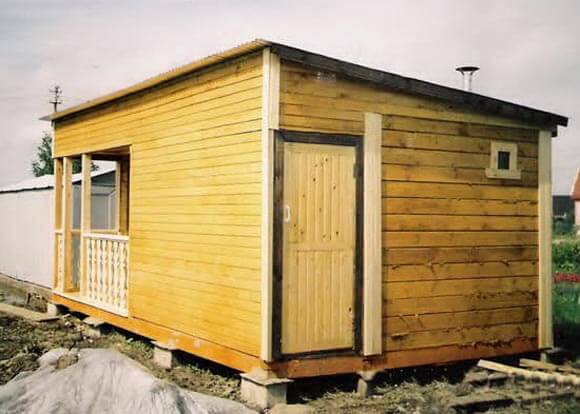
As a rule, the support of the rafters is made on two walls of different heights so that the lowest one is on the wind side, which will reduce the load. If there are identical walls in the building, the calculation of the roof frame should include measures to create the necessary slope with the help of racks, followed by sewing up the resulting pediment.
At the same stage, the side walls are laid, or they are assembled in a manner similar to the front part of the structure, where the supporting frame and cladding are involved. So, the reinforcement of single-pitched roofs is carried out by transverse girders, shown in the photo, which will become additional support for the rafter legs.
If the bearing walls are built of brick, then a Mauerlat is placed in front of it - a support for the rafters. For this, a solid bar with a section of 150x150 mm is taken, it is also permissible to use scraps of a bar from 1 m, after which the roof frame of the house will be reliably held by the wall.
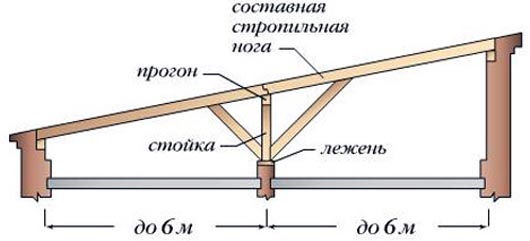
A chopped building can also be equipped with such a roof, then to compensate for the bursting loads arising from the uneven shrinkage of the logs, special sliding rafter mountings are installed.
The device of rafters to the Mauerlat is rigidly cut with cuts, and for additional connection of the elements, you will need construction brackets. For strength, the rafters are reinforced with struts, inclined posts (at an angle of 45 degrees), due to which the load is transmitted along the internal load-bearing walls or posts. All load-bearing elements must be predetermined and verified in additional calculations.
We insulate a pitched roof
You can insulate the roof using:
- Roll insulation based on fiberglass, for example, Ursa. Good performance coupled with low cost will be the best option (read also: "").
- Basalt slabs (mat) - they are easy to install, have high thermal insulation.
- Expanded polystyrene, it is better if it is extruded. The material is the most promising in the construction market. The only drawback is the lack of protection against spoilage by rodents.
- Liquid polyurethane foam, which is a new material. Due to the high cost, it is not available to all developers.
- The cheapest insulation is loose material (expanded clay, sawdust, slag).

In order to properly insulate the roof frames of houses, you need to pay attention to the analysis of the economic and technical factors of materials.
External insulation is carried out according to the scheme suggested below.
During the work, you need to be careful: the vapor barrier functions only in one direction, so it is important not to confuse the sides. This process is shown in more detail in the photo. Before the start of construction, it is imperative to clarify such nuances.
Further, a waterproofing membrane is attached to the rafters - it will prevent moisture penetration to the insulation layer. To create a ventilation gap between the waterproofing cake and the coating, bars from 20 mm are nailed onto the rafter legs.
One of the most popular options is a do-it-yourself shed roof. The main criterion for its popularity is a small amount of materials for construction and a fairly simple installation, therefore such a roof is installed almost everywhere - on residential buildings, outbuildings, sheds. Another advantage is good resistance to air currents: the angle of inclination of such a roof is low, and therefore gusts of wind hardly affect it (the average angle is 25 degrees, that is, the streamlining makes it possible to withstand almost a hurricane).
The only drawback can be considered the lack of an attic space, and the designers' comments about the appearance are no longer relevant - it is enough to choose the right roofing material, and the roof will look quite attractive. Due to the design features, the roof does not leak even during heavy long rains, and in winter it will provide excellent insulation and will not sag under a layer of wet snow.
For the device of a pitched roof, the first thing to do is to draw up an accurate project - for this it is worth contacting the professionals, they will complete the task much faster and better. They will also advise on how to choose wood for beams, floors and battens. And the roofing material is optional and depending on financial capabilities. The most budgetary option is slate, since finding it is a matter of minutes, and the price is more than acceptable, although a shed roof made of corrugated board is becoming more and more popular.
Rafter system
The shed roof rafter system is planned so that the bottom is on the leeward side and directs the flows upward. To do this, you need to find out the main wind direction in the region - at the meteorological center or through reports on the Internet. At the top of the wall, the beams are attached with a pitch of 70-80 cm to a seismic belt or Mauerlat along the upper masonry of the wall and are fixed with steel brackets. Rafters are attached to the beams - they will become a support for the roof, but the number of beams and supports must be equal. Thus, a right-angled triangle is obtained from the vertical leg to the edge of the roof.
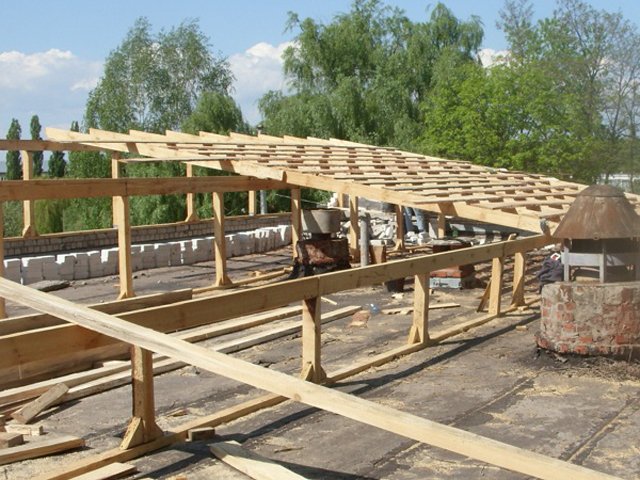
To fix the rafter leg, which will become the support of the sheathing, it is placed at one end in the lower part of the roof, and the other is attached to the vertical beam. This principle is the same for all beams, but you should carefully monitor the level - the angle of each part should be the same as the others - for this, it is enough to stretch several threads from edge to edge and align the height and slope along them.
Even a slight displacement will be noticeable after the roof is laid, and in the future, leaks and corrosion will be added to the appearance.
Sheathing and roofing
The scheme is no different from any other roof, but with its own amendments.
To fasten the sparse crate, 50x50 bars are taken. They are laid across the beams and nailed to the rafters and are designed for corrugated board or slate.

Solid sheathing is made of moisture-resistant plywood, edged boards or OSB and is designed for shingles, ondulin or metal profile. If the roof is made of slate, the distance between the beams should be sufficient for the sheet to overlap two slats, while leaving a margin of 15 cm on each side. How to build a pitched roof from corrugated board is described below.
Since today it came out on top and almost completely replaced slate, we will take it as the main option.
The sheets are stacked from bottom to top with an overlap of 15 cm. The top row lies on the bottom, the sheets are attached using special self-tapping screws with a rubber gasket to prevent leaks. It is possible to lay a layer of glass wool in overlapping strips for better waterproofing and preventing drafts, while maintaining proper ventilation under the roof. For different purposes use different type professional flooring:
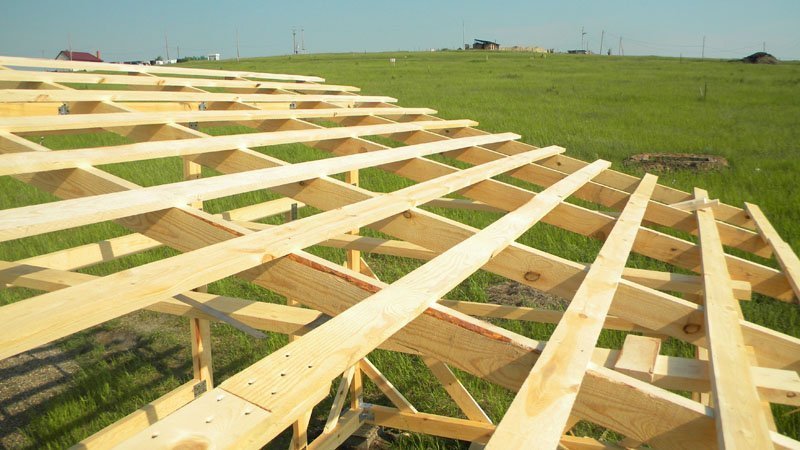
- For light roofing and decorative installation - C (wave height - 8 and 10 mm). Profile - trapezoid.
- For normal roofing or wall mounting - НС (height 35 and 44 mm).
- For reinforced roofs and floor slabs - H (height 57/60/75/114 mm). It has additional stiffening ribs and increased strength. Capital option.
Warming and vapor barrier
A do-it-yourself gable roof provides for the three most popular materials for insulation step by step:
- Cement-bonded slag. Low weight and price, but not the best thermal insulation. Plus, if it gets into it, it can seep into the room over time.
- Clay concrete. A more reliable option, it resists water well, but the problem with keeping heat is the same as in the previous case.
- URSA. The best option based on modern technologies and quality materials. Includes:
- insulation plates;
- flat blocks of fiberglass or a layer of glass wool;
- basalt insulation.

It is inexpensive, lasts a long time, and is easy to install. Excellent thermal insulation and moisture resistance make it one of the the best options, but fits in a strict sequence according to the instructions. The first layer provides vapor / waterproofing and dryness. If installed incorrectly, water entering the slabs will destroy them and repairs will be necessary over time, so be careful. Although there is a "fuse" - URSA, already covered with metal foil, thanks to which moisture is guaranteed not to get inside.
The most popular material for vapor barrier is isospan. Inexpensive, easy to install and protects not only from steam, but also from water getting under the roof - a kind of "control light". You can choose either for a specific type of roof (if you have decided on the materials / layout), or a station wagon (its indicators are averaged, but you can fit anything you like).

The vapor barrier is attached to rafter system under thermal insulation and fixed either with a stapler or with zinc nails. Can also be mounted on the rough lining of the attic. Everything lays down in strips from the bottom up, at all joints an overlap of 15 cm is made. For better sealing, you can glue the joints with special tape. The gap between the vapor barrier and interior decoration - at least 5 cm for ventilation. After that, a do-it-yourself shed roof is considered complete.



